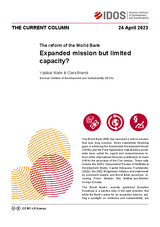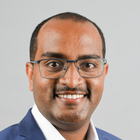The reform of the World Bank
Expanded mission but limited capacity?
Walle, Yabibal / Clara BrandiThe Current Column (2023)
Bonn: German Institute of Development and Sustainability (IDOS), The Current Column of 24 April 2023
The World Bank (WB) has launched a reform process that was long overdue. Given substantial financing gaps in achieving the Sustainable Development Goals (SDGs) and the Paris Agreement, stakeholders worldwide have called for urgent and comprehensive reform of the international financial architecture to make it fit for the polycrises of the 21st century. These calls include the G20’s Independent Review of Multilateral Development Banks Capital Adequacy Frameworks (2022), the 2022 Bridgetown Initiative and statements by prominent leaders and World Bank governors, including Prime Minister Mia Mottley and Minister Svenja Schulze.
The World Bank’s recently published Evolution Roadmap is a positive step in the right direction. But while the Bank’s plans for an expanded mission, putting a spotlight on resilience and sustainability, are welcome, they must be met with a corresponding substantial increase in its financing capacity. During the 2023 Spring Meetings (April 10-16), the shareholders of the World Bank did not make enough progress to tackle this challenge.
One key element of the World Bank’s reform is to put a stronger focus on financing solutions for global challenges. Until now, the Bank’s focus has been above all on supporting individual countries and less on global public goods that transcend national borders, such as the reduction of carbon emissions, pandemic preparedness or the protection of tropical forests. Under the new roadmap, the Bank could offer national governments cheaper and more loans to incentivize the provision of such global public goods, moving beyond the traditional focus of poverty reduction and promoting shared prosperity.
Expanding the Bank’s mission is an important goal. But it requires a massive increase in its financing capacity. There are three major possible ways to increase the Bank’s firepower: a capital increase by its shareholders, a better leverage of the World Bank’s balance sheets, and private capital mobilization. First, disappointingly, shareholders did not commit to any capital increase during the Spring Meetings. Secondly, and more positively, shareholders agreed to lower the equity-to-loan ratio, indicating how much debt the World Bank can take on relative to the value of its assets, from 20% to 19%. This step, together with other related changes in the Bank’s use of its capital, is expected to increase the Bank’s financing capacity by up to $50 billion over the next ten years. However, this amount is far less than would be required to implement the Bank’s ambitious reform agenda. For example, the 2022 Songwe-Stern report estimates that developing countries will require $1 trillion in external infrastructure finance annually through 2030 to reduce emissions in line with the 1.5°C goal. Consequently, financing the World Bank’s reform agenda will heavily depend on the third possibility: catalyzing private capital.
Such a focus on private capital, however, entails several risks. Most importantly, previous experience has shown that blended finance, i.e. the strategic use of public development finance for the mobilization of additional private finance, is struggling to take off, with amounts averaging $10.7 billion annually for the period 2011-2022. Therefore, the Bank's heavy reliance on an approach that – so far – has largely failed is a very risky strategy. In addition, blended finance involves trade-offs between private return and public benefit. Increased reliance on blended finance without strengthened transparency mechanisms to ensure that promised impacts for sustainable development and global public goods materialize could undermine the Bank’s ability to deliver on its expanded missions.
The lack of a convincing strategy to increase the World Bank’s financing capacity is worrying. Care must be taken to ensure that scarce concessional resources are not diverted from poverty reduction to the provision of global public goods. Failure to do so will have dire consequences. Growth and poverty reduction have already stalled due to the COVID-19 pandemic, the growing debt crisis, and the cost of living crisis fueled by the Russian invasion into Ukraine. Moreover, the incorporation of global public goods into the Bank’s mission threatens to shift the geographical focus of the Bank from low-income countries (LICs) to middle-income countries (MICs), which might reduce the Bank’s support for poorer nations.
In sum, the World Bank is right in stating that “concessional financing for MICs should be additional, to tackle essential global challenges, and not at the expense of poorer countries”. However, keeping this commitment will necessitate significant capital increases from shareholders as well as bold changes that better leverage the Bank’s balance sheet to unlock additional financial resources.



